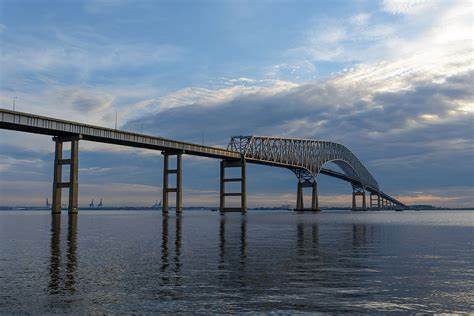BARGE CRANES ESSENTIAL IN BRIDGE CLEANUP
On March 26, sections of the Francis Scott Key bridge in Baltimore collapsed after a mammoth cargo ship, the Dali, collided with one of its piers. Tragically, six people died and an organized effort immediately began to clean up the debris and recover the remains of workers, four of whom are still missing.
The accident suspended operations at the Baltimore Port and a fleet of barge cranes were enlisted to help with the cleanup. Leading the charge is the Chesapeake or “Chessy,” a 1,000-ton lift capacity derrick barge, owned by Donjon Marine. It is the largest crane on the East Coast that was once used by the CIA.
Also supporting the operation, according to a Navy news release, are the Ferrell, a 200-ton lift capacity revolving crane barge and the Oyster Bay, a 150-ton lift capacity crane barge. Another 400-ton lift capacity barge is on site. In addition, 12 crane and support vessels including tugs, survey dive and crew boats and more than 50 salvage divers are helping with the operation.
The Navy is using the barges to remove submerged portions of the Francis Scott Key Bridge. The disassembled pieces will be lifted onto barges, which will then be transported away.
As catastrophic as the accident was, it could have been worse. Beneath the grounded 248-million-pound ship is a high-pressure natural gas pipeline. If it had been damaged in the accident, it could have caused an explosion. The Dali’s mayday call also alerted authorities, who were able to close the bridge to traffic minutes before the collision.

ENGINEERING CHALLENGE
Above the water, salvage teams are using torches to cut and remove massive chunks of the bridge. A section of the bridge is still draped across the bow of the Dali.
Operations underwater to remove the submerged sections have been hazardous. Dive teams face razor-sharp metal wreckage as they cut the sections into smaller pieces to be lifted out of the water. The water is so cloudy and dark, divers can only see a foot or two in front of them.
“Visibility makes it very difficult to even determine where to cut, how to cut, it’s very dangerous for our divers to go into this area.” Col. Estee Pinchasin of the US Army Corps of Engineers in Baltimore.
While Barnhart is not involved in the salvage operation, its engineers appreciate the difficulty the teams are facing. “Underwater recovery and rigging operations are extremely difficult due to a multitude of increased challenges that are typically not an issue in land-based operations,” said John Enberg, Vice President of Engineering at Barnhart. “Therefore, proper contingencies must be included in the plan that accommodate for various effects due to barge motion, suction forces present when lifting the structure out of the seabed and potential dynamic loading during the cutting sequence.”
Additional challenges due to how the collapsed structure came to rest on the seabed amplify the risk further. “Collapsed structures are often difficult to predict how they will respond during the dismantling process. Prior to recovery operations, a survey is usually completed to determine how the structure is supported in the post collapsed condition. Engineers develop a model that accurately represents how the structure will react as it is segmented to ensure stability is maintained during cutting, rigging & lifting operations.”
Crews have started removing some of the 4700 containers from the Dali’s deck. In the meantime, temporary alternate channels have been cleared to allow for some port traffic. Officials hope to restore normal capacity to Baltimore’s port by the end of May.
